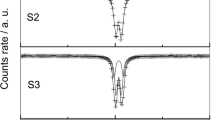Abstract
Mn-substituted iron oxides were synthesized by coprecipitating Fe(NO3)3 and Mn(SO4) solutions with NH4OH, adjusting the suspensions to pH 4 or 6, and then keeping the suspensions at 55°C for 62 days. The Mn mole fraction of the final products ranged from 0 to 0.3. X-ray powder diffraction patterns showed that goethite and hematite formed in each Fe-containing system. Groutite formed in systems having initial Mn mole fractions ≥0.35. Only manganite and hausmannite formed in the pure Mn systems. The oxalate-soluble Fe in the samples increased as the Mn mole fraction increased and was slightly larger for the pH 6 series.
For samples that contained the largest Mn mole fraction, the b and c dimensions of the goethite unit cell were shifted toward those of groutite, and the b and c dimensions of the groutite unit cell were shifted toward those of goethite. Assuming the Vegard rule holds for the unit-cell c dimension, the goethite accommodated a maximum Mn mole fraction of 0.34, and the groutite accommodated a maximum Fe mole fraction of 0.31. The unit-cell dimensions of hematite did not vary systematically with the mole fraction of Mn in solution, probably because little Mn substituted into the hematite structure.
Similar content being viewed by others
References
ASTM (1964) Index to the Powder Diffraction File: ASTM Special Technical Publication 48-M1, ASTM, Philadelphia, p. 326.
Burns, R. G. (1970) Mineralogical Applications of Crystal Field Theory: Cambridge University Press, Cambridge, 106–127.
Chao, T. T. and Theobald, P. K. (1983) The significance of iron and manganese oxides in geochemical exploration: Econ. Geol. 71, 1560–1569.
Cornell, R. M. and Giovanoli, R. (1987) Effect of manganese on the transformation of ferrihydrite into goethite and jacobsite in alkaline media: Clays & Clay Minerals 35, 11–20.
Dent-Glasser, L. S. and Ingram, L. (1969) Refinement of the crystal structure of groutite, α-MnOOH: Acta Crystallogr. B24, 1233–1236.
Fernandez, R. N. and Schulze, D. G. (1987) Calculation of soil color from reflectance spectra: Soil Sci. Soc. Amer. J. 51, 1277–1282.
JCPDS (1980) Mineral Powder Diffraction Files: Data Book: JCPDS International Center for Diffraction Data, Swarth-more, Pennsylvania.
Karim, Z. (1984) Influence of transition metals on the formation of iron oxides during the oxidation of Fe(II)Cl2 solution: Clays & Clay Minerals 32, 334–336.
Klug, H. P. and Alexander, L. E. (1974) X-ray Diffraction Procedures for Polycrystalline and Amorphous Materials: Wiley, New York, 966 pp.
Lim-Nunez, R. and Gilkes, R. J. (1987) Acid dissolution of synthetic metal containing goethites and hematites: in Proc. Int. Clay Conf, Denver, 1985, L. G. Schultz, H. van Olphen, and F. A. Mumpton, eds., The Clay Minerals Society, Bloomington, Indiana, 187–204.
Lindsay, W. L. (1979) Chemical Equilibria in Soils: Wiley, New York, 449 pp.
Schulze, D. G. (1981) Identification of soil iron oxide minerals by differential X-ray diffraction: Soil Sci. Soc. Amer. J. 45, 437–440.
Schulze, D. G. (1984) The influence of aluminum on iron oxides. VIII. Unit-cell dimensions of Al-substituted goethite and estimation of Al from them: Clays & Clay Minerals 32, 36–44.
Schulze, D. G. (1986) Correction of mismatches on 20 scales during differential X-ray diffraction: Clays & Clay Minerals 34, 681–685.
Schwertmann, U. (1964) Differenzierung der Eisenoxide des Bodens durch Extraktion mit einer Ammoniumoxalatlö-sung: Pflanzenernaehr. Bodenkd. 105, 194–202.
Schwertmann, U. (1987) Some properties of soil and synthetic iron oxides: in Iron in Soils and Clay Minerals, Proc. of NATO Adv. Study Inst., J. W. Stucki, B. A. Goodman, and U. Schwertmann, eds., D. Reidel, Boston, 203–250.
Schwertmann, U. and Murad, E. (1983) Effect of pH on the formation of goethite and hematite from ferrihydrite: Clays & Clay Minerals 31, 277–284.
Shannon, R. D. and Prewitt, C. T. (1969) Effective ionic radii in oxides and fluorides: Acta Crystallogr. B25, 925–946.
Stiers, W. and Schwertmann, U. (1985) Evidence for manganese substitution in synthetic goethite: Geochim. Cos-mochim. Acta 49, 1909–1911.
Author information
Authors and Affiliations
Additional information
Journal article number 11,250, Purdue Agricultural Experiment Station.
Rights and permissions
About this article
Cite this article
Ebinger, M.H., Schulze, D.G. Mn-Substituted Goethite and Fe-Substituted Groutite Synthesized At Acid pH1. Clays Clay Miner. 37, 151–156 (1989). https://doi.org/10.1346/CCMN.1989.0370206
Received:
Accepted:
Published:
Issue Date:
DOI: https://doi.org/10.1346/CCMN.1989.0370206




